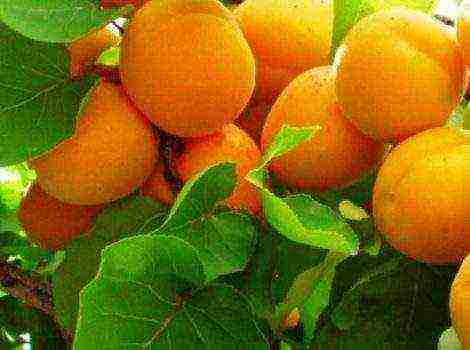Content
- 1 A detailed description of the Maaka bird cherry variety
Detailed description of the Maaka bird cherry variety
Bird cherry is an amazingly beautiful tree, the flowering of which is associated with the perception of spring. But, many gardeners do not plant it on their plots, believing that this plant attracts all kinds of parasites, even contributes to their reproduction and settlement in the garden. In this article, let's take a closer look at the description and rules for caring for the Maak bird cherry.
In fact, the opposite is true, the leaves and inflorescences of the tree secrete a large amount of phytoncides, which are deadly poison for most harmful microorganisms and small insects, such as ticks, midges or mosquitoes. That is why, if you leave a large bouquet of bird cherry in the room, people get a headache.
Same do not forget about the tasty and healthy berries that this tree gives... You can cook jam, compotes from them, use them as a filling for baking, or just eat, provided that the planted variety is edible.
At the moment, summer residents have access to about twenty varieties of this wonderful plant, both with edible fruits and ornamental, including the Maak bird cherry.
Description bird cherry variety Maaka
The bird cherry, known to gardeners as Maaka, was first described in detail by the world renowned botanist Franz Ivanovich Ruprecht for the Austrian Botanical Society in 1857. BUT this variety got its name from the surname of the Russian naturalist and researcher Richard Karlovich Maakwho described it during his travels in the Far East, the valleys of the Ussuri and Amur in 1855-59.
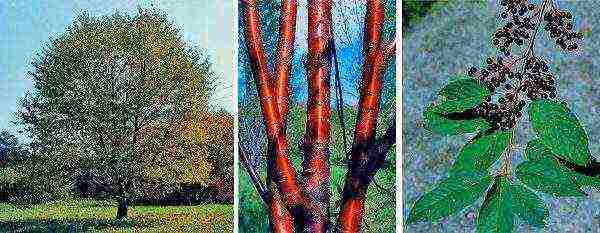
In nature, this tree, quite unlike the bird cherry growing in Siberia, is found along the banks of rivers and streams in China, Korea, and in Russia - in the Far East.
It is impossible not to notice such beauty - fluffy emerald leaves, light yellow shoots and white flowers scattered over the crown in spring, or bunches of berries black with a purple tint at the end of summer. The bark is especially impressive - from golden-bronze to brown, shining in the rays of both the sun and the moon, peeling off in transverse stripes, which creates the appearance of a shaggy, translucent fringe.
Height of a tree in the wild reaches 16-18 meters, but trunk – 40 cm in diameter. This bird cherry blooms in late spring, with small flowers collected in elongated brushes.
By mid-July, drupes ripen. The bunches are very beautiful, but the fruits themselves are inedible for humans, due to strong bitterness and very coloring pulp. But, if you still take a chance and swallow a couple of berries, in addition to the long purple color of the tongue, you can get a good laxative effect.
Birds and squirrels are very partial to ripe drupes, and hedgehogs very quickly disassemble fallen berries.
The tree is extremely interesting not only for its external originality, but also for its universal characteristics, which allow this species to feel great in almost any summer cottage in the middle lane.
Bird cherry Maak:
- frost-resistant, easily tolerates subzero temperatures up to 40-45 degrees;
- not very demanding on soil, grows on any land, but looks most impressive where it is planted on well-moistened sandy loam.
- not susceptible to droughts, only a seedling needs watering in the first year of planting, but even then not always;
- calmly suffers temporary flooding and lingering rains;
- can grow in the shade, but feels much better in an open sunny meadow;
- leaving comes down to formation of the desired crown shape;
- indifferent to haircuts, transplants, tiled, iron or asphalt pavement over the root system;
- possesses very rapid growth;
- propagated by seeds, but will not mind breeding with cuttings.
Indeed, a completely versatile variety.
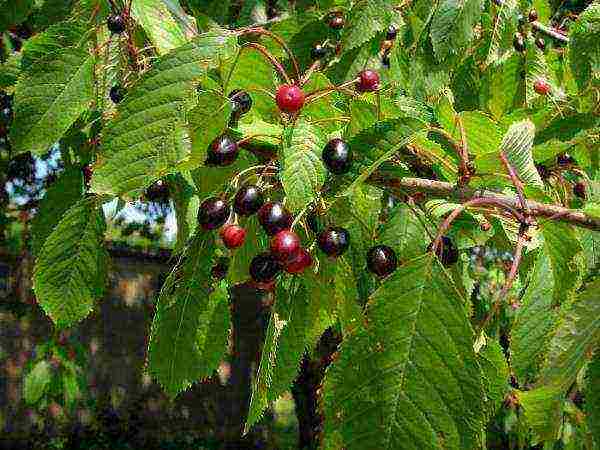
These qualities attracted the famous breeder Michurin in Maak's bird cherry, when he and his employees worked to improve the characteristics of the cherry. During the first crosses, many hybrids were obtained, of which in further work only the results of combining bird cherry with steppe cherry and the previously bred garden variety Ideal were used... Introduced to the botanical world and gardeners, the finalized species of hybrid trees are known under the general name of cerapadus, that is, cherry turtles.
Characteristics of the Maaka variety
Prunus maackii, or Padus maackii, as in Latin accepted in botany, this variety of bird cherry is called, has the following characteristics of interest to the gardener:
- tree height on average reaches 10-11 meters;
- straight shoots, "Erect", pubescent with alternate leaf arrangement;
- oval leaves, simple with jagged edges and pointed apex;
- inflorescences racemose;
- flowers are white, on average in 1 cm, five-petal, with a rich aroma;
- bears fruit with berries inedible for humans, in the ripening state - red, in the ripe stage - violet-black, lilac.
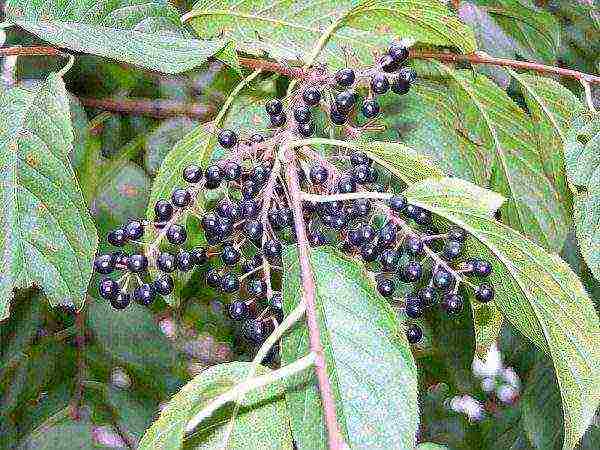
Advantages and disadvantages
Among the indisputable advantages of planting bird cherry on your own summer cottage, the following can be distinguished:
- unpretentious to the composition of the soil;
- does not require careful maintenance;
- scares away midges, mosquitoes and ticks;
- does not need wateringexcept for the first year of life;
- has unlimited potential when creating landscape compositions;
- fast growth;
- grows both in bright sun and in the shade.
The disadvantages of planting this tree in the garden include such moments as:
- photophilous tree, the minimum distance between seedlings should be 5 meters, and if bird cherry is determined to live in the shade, then more;
- abundant root growth;
- inedibility of drupeswith which the Maaka variety bears fruit;
- opportunity to get headaches with a long stay next to a flowering tree;
- attracting bees, bumblebees and wasps during the flowering period, which is extremely dangerous for allergy sufferers.
Landing rules
It is not difficult to choose a place for Maak's bird cherry, it will look great and take root well in any corner of the garden. If there are wet places on the site, for example, due to the close approach of soil, then the tree will perfectly dry such a surface.
From an aesthetic point of view, this plant is combined with almost everything in the world, looks great both in a group of plantings, for example, when alternating with shrubs along the borders of the site, and independently, against the background of lawn grass, in a corner near outbuildings.
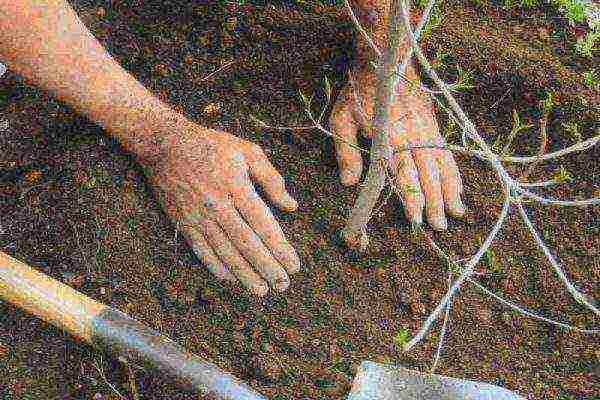
This variety is very not capricious, it tolerates transplanting well, quickly adapts and takes root in a new place, therefore, there are no special tricks when planting a tree. General guidelines should be followed, such as:
- prepare the landing pit, it is not necessary to particularly deepen and get carried away with fertilizers, especially organic ones, their excess can destroy the seedling;
- optimum seedling height 70-75 cmif the planting material is higher, it is better to shorten it;
- when planting two or more plants, which is good for cross-pollination, the distance between them should be 5-6 meters;
- in the pit you need distribute roots and fall asleep, watering abundantly;
- soil around the planting mulch a little.
Tree care
It is easy to care for bird cherry - in the first year or two of its life on the site, the tree needs to be watered periodically, it is also important to pay attention to the formation of the future crown in the first years of plant growth.
When the first lateral shoots appear, it is advisable to leave 4-5 of the most developed and looking in different directions... The same will have to be done with the branches growing on them. The upper shoot must be pruned in order for the lateral ones to develop as much as possible. It is better to process the cuts with a garden pitch.
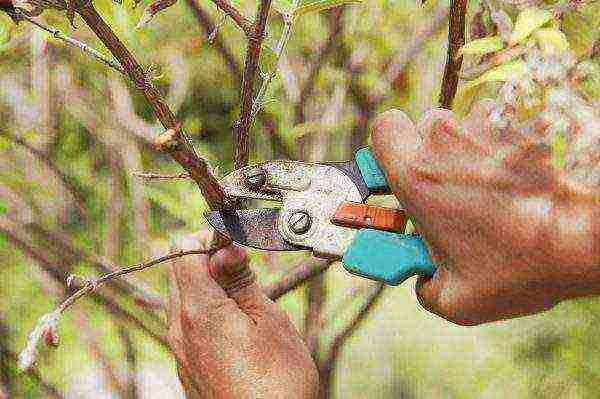
This will take several years. In an already mature tree, if desired, you can thin out the crown.
As for all kinds of dressings, it makes no sense to make them more often than once every couple of years. If there is a desire, then you can make a little mineral dressings before the flowering bird cherryto make it longer and more abundant.
Diseases and pests
Any bird cherry, including the Maaka variety, is resistant to various pests. But this does not mean that the tree cannot get sick at all.
The most common ailments that overtake this plant are fungal diseases. The fungus affects:
- fruit;
- branches and leaves;
- bark and trunk.
Diseases of the fetus
Drupes (popular name for this variety of bird cherry berries) are ill in the form of deformation, the so-called "pockets". The fungus affects the fruit, as a result of which the ovary grows, that is, the fleshy part and almost no bone develops.
Infected drupes take the form of brown, large, swollen formations with empty cavities inside - pockets. The development of infection leads to a loss of yield and a violation of the decorative attractiveness of the tree.
To protect against this fungus, you need to destroy the damaged fruits, and the tree itself must be treated with agents containing copper. It will also require treatment of the damaged plant in the spring, before bud break.
Diseases of leaves and branches
Leaf rust
This disease develops mainly in forests and parks, but can also visit gardens. The fungus that causes this trouble lives in spruce cones.... From where it migrates to the leaves and branches of bird cherry.
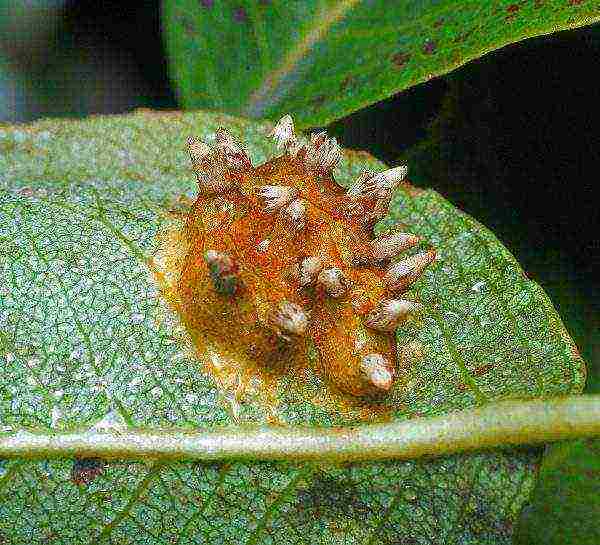
In June, brown or purple spots form on the foliage, the same formations on the branches. By the end of summer, the tree completely loses its aesthetic appeal.
As a fight against this disease, bird cherry is sprayed with vitriol, look for the source of the fungus - spruce and destroy all the cones on it.
Clasterosporia, or spotting
Hole spot

Expressed in the fact that in June or in the first half of July, the leaves are covered with brownish-brown spots with a bright crimson border... With the course of the disease, these spots fall out, and the tree gives the impression of being eaten by insects.
Brown spot
Towards the end of summer on foliage brown round through spots with a yellow pad on the upper part are formed... This yellowish formation is the sporulation of the fungus. With a strong development of the disease, the entire leaf is covered.
Orange spot
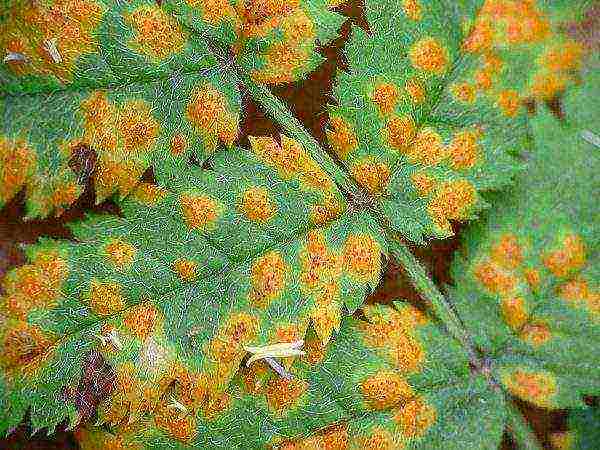
In the middle of summer on the leaves orange angular spots appear, up to 10 mm in diameter... Flat, brightly colored. With the development of the fungus, they can merge, occupying a significant leaf area. This disease is common in Siberia and the Far East.
Purple spot
It is characterized by the appearance of round grayish-purple spots with indistinctedges flowing into the color of the sheet. It can appear throughout the summer and very quickly cover most of the crown of the tree.
As a fight against all types of spots, fallen leaves are destroyed, and the crown of trees is treated with a Bordeaux mixture or foundation several times during the summer season.
Moniliosis, or monilial burn
An unpleasant disease in which the fungus infects flowers, foliage, shoots and drupes. In the spring, the branches begin to dry out, acquiring a bright brown color., then the same thing happens with leaves and shoots.
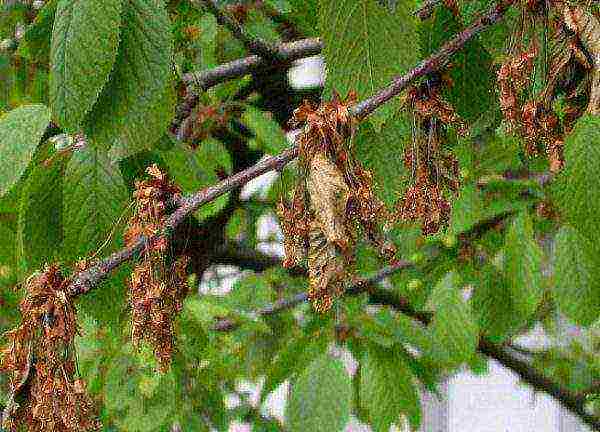
The fungus grows very well in high humidity, making the tree look similar to the one affected by the fire.
To prevent and protect against this disease, the damaged areas are cut and destroyed., and in the spring, before flowering, the tree is treated with Bordeaux liquid. Re-spray it after flowering and in the fall. Be sure to destroy fallen leaves.
Diseases of the trunk and bark
Cytosporosis or cytospore necrosis
When affected by this fungal infection, tree bark dies off in rings on the trunk and branches... Inside these areas, a cluster of small red cones tightly adjacent to each other is clearly visible - this is the sporulation of the fungus.
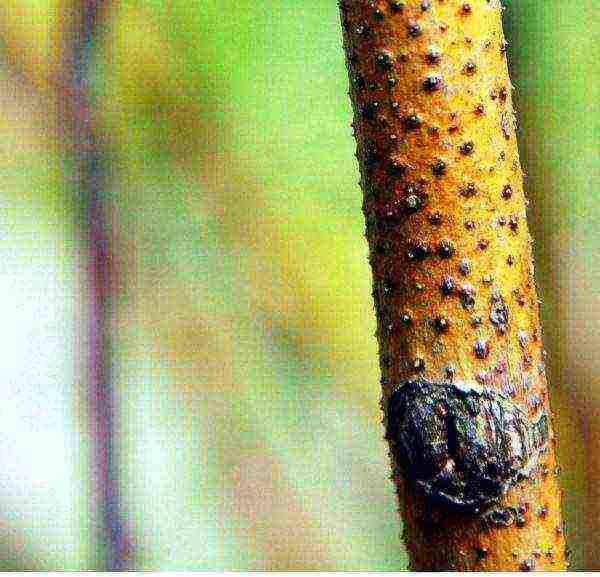
This necrosis usually affects plants weakened by something and can kill the tree.
There are no effective measures to combat this disease; gardeners usually cut off damaged areas and destroy them., and the zones of development of the fungus on the trunk are cleaned, washed with soap and copper, disinfected and covered with garden var.
Gum therapy
On the tree, there are areas with an escaping liquid - gum. It is an amber-colored, gummy, gummy substance. It usually accompanies other diseases, such as spotting, moniliosis, cytosporic necrosis, as well as mechanical damage to the bird cherry trunk, frosty sunburn, which, although very rare, also occur. The disease leads to the death of shoots, branches, and sometimes the bark of the tree.
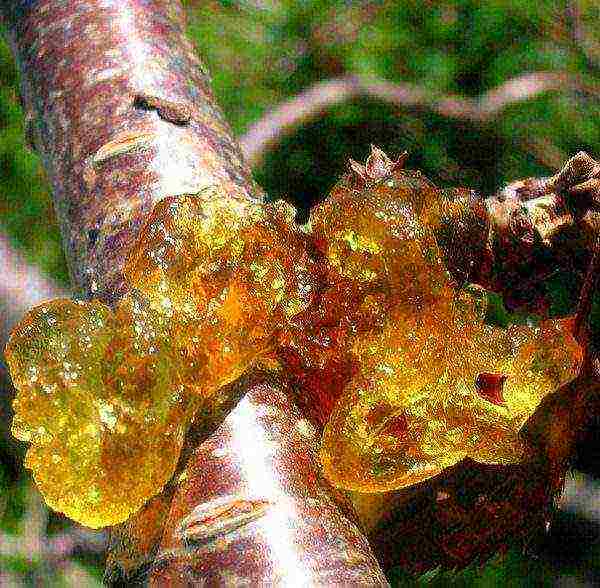
Fighting this infection means curing the bird cherry from the underlying disease. and pruning of dead branches and shoots with their subsequent destruction.
Brown root rot
The disease begins due to the activity of the tinder fungus Schweinitz, that is, simply rot. The fungus develops in the central part of the root system and directly on the trunk of the tree... At the same time, velvety large mushrooms grow on it at the base of the bird cherry.

Old and weak trees are most often affected. In forests, forest parks, urban plantings. It is extremely rare in the garden.
Of the rot that settle in bird cherry, the most common fungi are pathogens such as:
- plum tinder fungus;
- sulfur-yellow tinder fungus;
- purple tinder fungus;
- false tinder fungus.
The danger of such a disease is that sooner or later the tree will fall. There is only one method of struggle:
- saw cut;
- uprooting;
- burning a hole.
Bird cherry pests
Bird cherry is very resistant to all kinds of pests, but some still make their way through her phytoncide defenses.
The most common insects that overtake the Maak bird cherry and harm it are:
Sucking pests

These are all insects that feed on the sap of foliage, buds, shoots, branches and trunk. The most frequent guests and inhabitants of the tree are coccids, leaf flies, plant bugs.... Most of them infect other trees in the garden, for example, an apple or plum tree, and then they get to the bird cherry.
Leaf-eating insects
This is:
- caterpillars of butterflies;
- sawfly larvae;
- the larvae of leaf beetles and the beetles themselves;
- hawthorn and bird cherry moth.
- Ermine bird cherry moth
- Bird cherry moth larvae
- Harm from bird cherry moth
Some caterpillars, of the same hawthorn moth, weave peculiar nests from leaves, in which they live and feed.
Miners
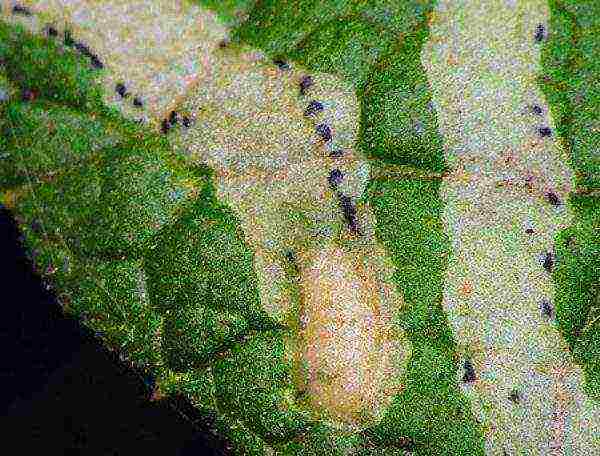
The larvae of this type of pest feed and grow inside the leaf, leaving hollow veins in it, different in shape and color. They move to bird cherry from apple trees.
Gall producers
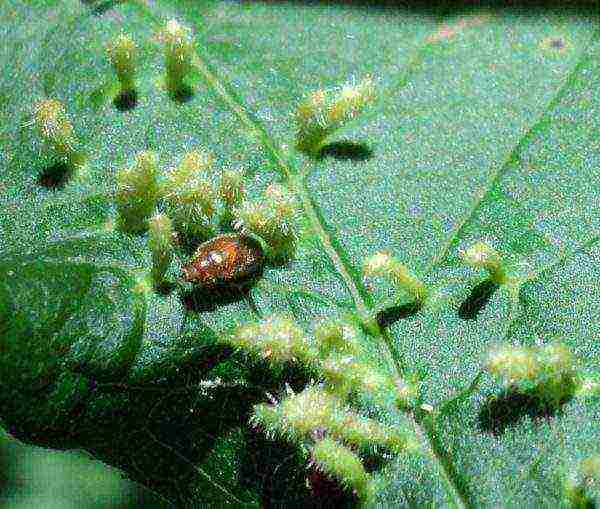
Galls in the form of white or pink horns up to 4 mm long create mites - gall and felt. They are very rare on bird cherry, only in the presence of heavily infested trees nearby.
Stem pest insects
These are xylophagous insects, that is, bark beetles and woodworms. About twenty different species live on bird cherry, but they only affect old, dying or diseased trees.
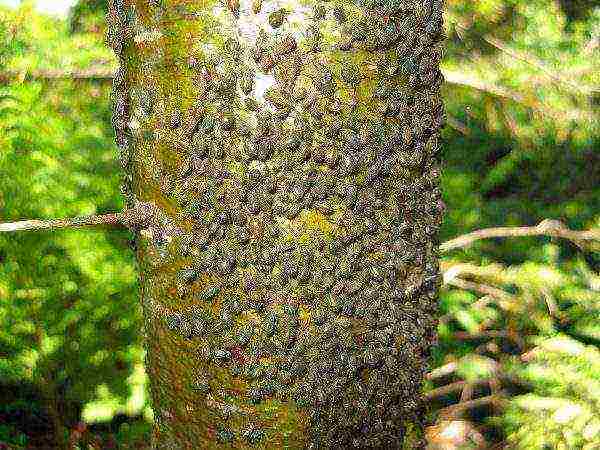
The main way to combat all these pests is chemical. The affected tree must be treated twice with such means as:
- karbofos;
- kinmix.
With a very strong infection, a third spraying may be required, but, usually, after the second, all insects have already died.
Preventive measures include thinning the crown, pruning old branches, whitewashing the trunk and bases of the branches, and, of course, careful monitoring of the condition of the bird cherry neighbors in the garden plot.
Maaka bird cherry is an amazingly beautiful tree with a number of decorative and useful properties. Despite the fact that its fruits are inedible for humans, they are perfect for the manufacture of medicinal decoctions and infusions.that can solve many bowel problems.
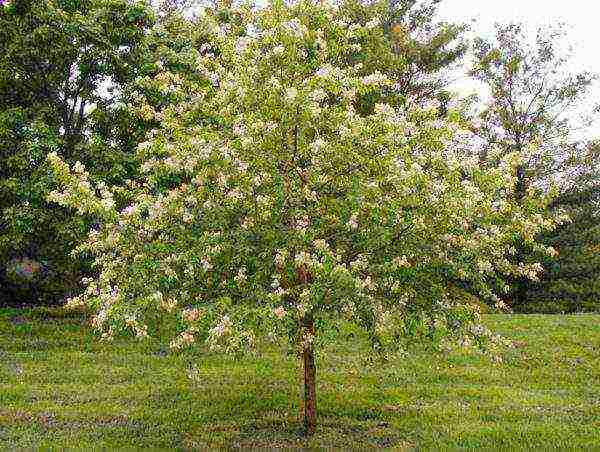
When choosing bird cherry for your garden, you should pay attention to this completely unpretentious tree, which will ideally fit into any landscape composition, create a shadow over the recreation area and scare away mosquitoes from it, as well as create a lyrical mood for the owners of the garden.
Rarely what the tree boasts such disease resistance, ease of survival, unpretentiousness to soil and weather, undemanding care, rapid growth and unique external beauty, like the Maak bird cherry.

